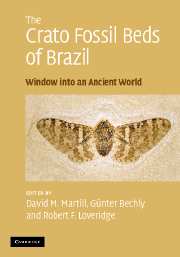Book contents
- Frontmatter
- Contents
- Contributors
- Preface
- Acknowledgements
- Part I The Crato Formation Konservat Lagerstätte
- Part II The invertebrate fauna
- Part III The vertebrate fauna
- Part IV The flora
- Part V Miscellanea
- 21 Miscellaneous biota
- Appendix: species list for the Crato Formation
- Systematic index
- Plate section
- References
21 - Miscellaneous biota
Published online by Cambridge University Press: 22 August 2009
- Frontmatter
- Contents
- Contributors
- Preface
- Acknowledgements
- Part I The Crato Formation Konservat Lagerstätte
- Part II The invertebrate fauna
- Part III The vertebrate fauna
- Part IV The flora
- Part V Miscellanea
- 21 Miscellaneous biota
- Appendix: species list for the Crato Formation
- Systematic index
- Plate section
- References
Summary
The Crato Formation yields a number of fossils and other, possibly fossil, objects that are somewhat puzzling. The most conspicuous of these are the small (usually 5–10 mm in length) pellet-like structures that often cover the bedding surfaces. Others are less mysterious, but their presence in the formation is hard to explain, such as the isolated occurrence of pieces of amber. Below is a review of some of these objects with possible explanations for their occurrence and identity.
Pelleted bedding planes
A characteristic of many bedding surfaces in the Nova Olinda Member is the super-abundance of evenly distributed pellet-like structures (Figure 21.1). On fresh surfaces they appear to be black or dark grey, but are usually brown or orange on weathered surfaces. When found in early diagenetic concretions they are clearly cylindrical. Most are straight, or only slightly curved, they never bifurcate and lengths may vary from 2 to 15 mm while the diameter is usually between 0.5 and 1.5 mm. Hydrofluoric acid extraction of unweathered specimens showed that they can contain high concentrations of palynomorphs. Their occurrence within larger coprolites that also contain bones is puzzling. Their pellet-like morphology suggests that they are just that: faecal pellets. Their size and super-abundance would suggest that they were generated by young individuals of the fish Dastilbe. The high abundance of palynomorphs within the pellets is then easily explained as a consequence of the filter-feeding activities of young Dastilbe.
- Type
- Chapter
- Information
- The Crato Fossil Beds of BrazilWindow into an Ancient World, pp. 577 - 581Publisher: Cambridge University PressPrint publication year: 2007
References
- 1
- Cited by

